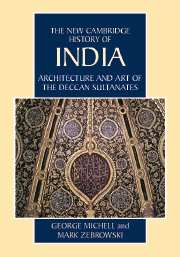Book contents
- Frontmatter
- Introduction
- 1 Historical framework
- 2 Forts and palaces
- 3 Mosques and tombs
- 4 Architectural decoration
- 5 Miniature painting: Ahmadnagar and Bijapur
- 6 Miniature painting: Golconda and other centres
- 7 Textiles, metalwork and stone objects
- 8 Temples
- 9 Conclusion
- Appendix: Dynastic Lists of Deccan Rulers
- Bibliographic Essay
- Bibliography
- Index
- Map of the Southern Deccan"
- Plate Section"
1 - Historical framework
Published online by Cambridge University Press: 28 March 2008
- Frontmatter
- Introduction
- 1 Historical framework
- 2 Forts and palaces
- 3 Mosques and tombs
- 4 Architectural decoration
- 5 Miniature painting: Ahmadnagar and Bijapur
- 6 Miniature painting: Golconda and other centres
- 7 Textiles, metalwork and stone objects
- 8 Temples
- 9 Conclusion
- Appendix: Dynastic Lists of Deccan Rulers
- Bibliographic Essay
- Bibliography
- Index
- Map of the Southern Deccan"
- Plate Section"
Summary
Though most of the monuments and works of art surveyed in this volume are categorised as Sultanate, Mughal or Maratha, these essentially stylistic designations should not be understood as implying chronologically discrete periods. The chief sultans of the Deccan maintained their independence for more than a century after the Mughals first invaded the region at the end of the sixteenth century. This means that Sultanate and Mughal epochs overlapped rather than one succeeding the other. From the last quarter of the seventeenth century onwards the Mughals and Marathas were forced into an uneasy coexistence. This led ultimately to the distintegration of the great North Indian empire. Such concurrent dynastic developments, though resulting more often in war than in peace, form the background to the highly spirited artistic tradition that is the subject of this volume.
The turbulent events of these centuries are explained to some extent by the unique location of the Deccan plateau as a meeting place of forces from both North and South India, the promise of boundless land and wealth inspiring repeated invasion. In the first decades of the fourteenth century, the Deccan was subjugated by the Khaljis and Tughluqs, the first Muslim rulers of Delhi; some two and a half centuries later the Mughals arrived, though it took them more than one hundred years to consolidate their conquests. Resistance to these assaults from Delhi occurred in three waves: the military thrust of the mighty Hindu Vijayanagara kingdom south of the Tungabhadra–Krishna rivers in the fifteenth and first half of the sixteenth centuries; the opposition of the Shia Muslim sultans throughout most of the seventeenth century; and the guerilla tactics of the Hindu Maratha warriors in the second half of the seventeenth and first half of the eighteenth centuries.
Keywords
- Type
- Chapter
- Information
- Architecture and Art of the Deccan Sultanates , pp. 4 - 22Publisher: Cambridge University PressPrint publication year: 1999

